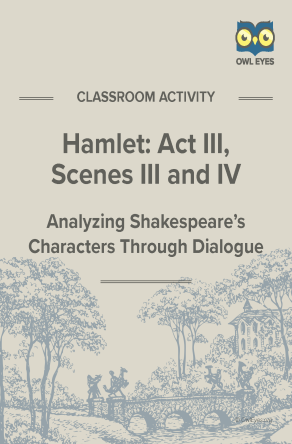Hamlet Act III, Scenes III and IV Dialogue Analysis Activity Worksheet
- 11 pages
- Subject: Character Analysis, Tone, Lesson Plans and Educational Resources
- Common Core Standards: RL.11-12.1, RL.11-12.5, RL.9-10.1, RL.9-10.3
- Grade Levels: 10, 11, 12
Additional Hamlet Resources
Product Description
Arguably Shakespeare’s greatest tragedy, Hamlet addresses regicide and its terrible consequences. As the prince of Denmark and heir to the throne, Hamlet returns home from Wittenberg to find that his father, King Hamlet, has died and his mother, Queen Gertrude, has married Claudius, the king’s brother, who now rules Denmark as an illegitimate but powerful monarch. Intensifying Hamlet’s shock and horror is learning that Claudius murdered King Hamlet to usurp the throne and satisfy his lust for Gertrude. Grieving for his beloved father and despising Claudius, Hamlet is driven by the need to avenge his father’s murder and by his conflicting feelings about Gertrude; he loves his mother but condemns her for marrying Claudius almost immediately after his father’s death. The toxic relationships among Hamlet, Claudius, and Gertrude developed throughout the play are underscored in act III, scenes III and IV, when Hamlet secretly observes Claudius in prayer and later confronts Gertrude in her bedchamber to unleash his fury over her betrayal of King Hamlet and their marriage. In these scenes, Claudius’s and Gertrude’s characters, as well as Hamlet’s, are revealed more fully.
Skills: character analysis, drawing inferences from text, interpreting diction for connotative meaning
Learning Objectives: By using this worksheet, students will be able to
- Analyze passages of dialogue to identify the speaker’s character traits, conflicts, and motivations
- Examine the diction in passages of dialogue to interpret the connotations of key words and explain how they create mood in the scene
- Determine from passages of dialog characteristics of the speaker’s relationship with another character in the play
About This Document
The Owl Eyes Dialogue Analysis activity for Hamlet gives students an opportunity to practice examining and analyzing passages from one of Shakespeare’s most popular plays. This worksheet focuses on the essential role of diction (word choice) in creating mood and subtext in each scene, developing characters, and establishing events in the plot. The main components of this activity include the following:
- A contextualized summary of the selected passages
- A selection of excerpts for examination
- A table with scaffolded question progression
- A step-by-step guide to activity procedure
- A complete answer key
In completing this activity worksheet, students will be able to analyze passages of dialogue to identify the speaker’s character traits, conflicts, and motivations as well as determine how diction creates mood.







